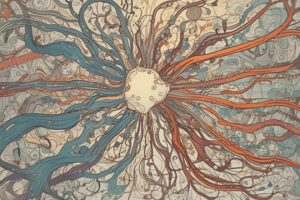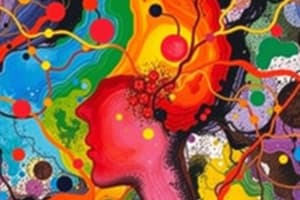Podcast
Questions and Answers
What effect can antipsychotics have on the tuberoinfundibular pathway?
What effect can antipsychotics have on the tuberoinfundibular pathway?
- They stimulate the production of prolactin during lactation.
- They can cause hyperprolactinemia. (correct)
- They can lead to an increase in dopamine levels.
- They improve dopamine signaling to the hypothalamus.
Which of the following symptoms is NOT typically associated with extrapyramidal symptoms (EPS)?
Which of the following symptoms is NOT typically associated with extrapyramidal symptoms (EPS)?
- Auditory hallucinations (correct)
- Tremors
- Restlessness
- Rigid movements
Which type of hallucination is most commonly associated with psychotic disorders?
Which type of hallucination is most commonly associated with psychotic disorders?
- Auditory hallucinations (correct)
- Gustatory hallucinations
- Visual hallucinations
- Tactile hallucinations
What condition can develop as a side effect of antipsychotic medications disrupting the tuberoinfundibular pathway?
What condition can develop as a side effect of antipsychotic medications disrupting the tuberoinfundibular pathway?
What is a defining criterion for diagnosing schizophrenia in relation to psychosis?
What is a defining criterion for diagnosing schizophrenia in relation to psychosis?
Which potential outcome is linked to the use of antipsychotic medications?
Which potential outcome is linked to the use of antipsychotic medications?
Which type of delusion is characterized by the belief that one's life has no meaning?
Which type of delusion is characterized by the belief that one's life has no meaning?
What is a common side effect associated with the medication Thorazine?
What is a common side effect associated with the medication Thorazine?
Which symptom is primarily associated with schizoaffective disorder?
Which symptom is primarily associated with schizoaffective disorder?
What is the main characteristic of brief psychotic disorder?
What is the main characteristic of brief psychotic disorder?
Which condition is characterized by chronic psychotic symptoms but with retained function and affect?
Which condition is characterized by chronic psychotic symptoms but with retained function and affect?
What is a common cause of tactile hallucinations?
What is a common cause of tactile hallucinations?
In the context of psychosis, what role does excess dopamine in the mesolimbic pathway play?
In the context of psychosis, what role does excess dopamine in the mesolimbic pathway play?
Which of the following does NOT characterize dissociative disorders?
Which of the following does NOT characterize dissociative disorders?
What would likely be an implication of normal dissociation?
What would likely be an implication of normal dissociation?
Which type of hallucination can be triggered by migraines?
Which type of hallucination can be triggered by migraines?
What is the primary association of the mesolimbic pathway in relation to psychosis?
What is the primary association of the mesolimbic pathway in relation to psychosis?
Which of the following pathways is most likely to be affected by antipsychotic medications in relation to schizophrenia?
Which of the following pathways is most likely to be affected by antipsychotic medications in relation to schizophrenia?
What can excessive dopamine binding at D2 receptors in the mesolimbic pathway lead to?
What can excessive dopamine binding at D2 receptors in the mesolimbic pathway lead to?
Which negative symptom of schizophrenia is specifically associated with reduced dopamine in the mesocortical pathway?
Which negative symptom of schizophrenia is specifically associated with reduced dopamine in the mesocortical pathway?
What side effect can occur from antipsychotics that block the nigrostriatal pathway?
What side effect can occur from antipsychotics that block the nigrostriatal pathway?
Which feature of psychotic disorders is most commonly associated with schizophrenia?
Which feature of psychotic disorders is most commonly associated with schizophrenia?
The tuberoinfundibular pathway primarily influences which of the following?
The tuberoinfundibular pathway primarily influences which of the following?
What symptoms are most likely to worsen as a result of further dopamine reduction in the mesocortical pathway due to antipsychotic treatment?
What symptoms are most likely to worsen as a result of further dopamine reduction in the mesocortical pathway due to antipsychotic treatment?
What primarily differentiates depersonalization from derealization in dissociative disorders?
What primarily differentiates depersonalization from derealization in dissociative disorders?
Which type of dissociative amnesia involves the loss of all memories from a specific time until the present?
Which type of dissociative amnesia involves the loss of all memories from a specific time until the present?
In dissociative fugue, which characteristic is common regarding identity?
In dissociative fugue, which characteristic is common regarding identity?
What is a key factor for the diagnosis of dissociative amnesia?
What is a key factor for the diagnosis of dissociative amnesia?
Which statement best describes a common misconception about somatic symptom disorder?
Which statement best describes a common misconception about somatic symptom disorder?
What commonly triggers identity switching in individuals with Dissociative Identity Disorder (DID)?
What commonly triggers identity switching in individuals with Dissociative Identity Disorder (DID)?
Why is it crucial for patients with somatic symptom disorder to acknowledge the mental health aspect of their symptoms?
Why is it crucial for patients with somatic symptom disorder to acknowledge the mental health aspect of their symptoms?
What is a characteristic of dissociative identity disorder that distinctly separates it from other dissociative disorders?
What is a characteristic of dissociative identity disorder that distinctly separates it from other dissociative disorders?
What is a key characteristic that differentiates conversion disorder from neurological disorders?
What is a key characteristic that differentiates conversion disorder from neurological disorders?
Which demographic is most commonly affected by Illness Anxiety Disorder?
Which demographic is most commonly affected by Illness Anxiety Disorder?
What is a common behavior exhibited by individuals with Factitious Disorder?
What is a common behavior exhibited by individuals with Factitious Disorder?
Which statement best describes malingering?
Which statement best describes malingering?
In the context of aberrant behavior in Factitious Disorder Imposed on Another, what is a typical reaction a caregiver might display upon receiving bad news about the child?
In the context of aberrant behavior in Factitious Disorder Imposed on Another, what is a typical reaction a caregiver might display upon receiving bad news about the child?
What is a primary feature of Psychological Factors Affecting Other Medical Conditions?
What is a primary feature of Psychological Factors Affecting Other Medical Conditions?
Which of the following is true about symptoms associated with conversion disorder?
Which of the following is true about symptoms associated with conversion disorder?
Which aspect of Factitious Disorder does Munchausen’s Syndrome highlight?
Which aspect of Factitious Disorder does Munchausen’s Syndrome highlight?
Flashcards are hidden until you start studying
Study Notes
Dopamine and Psychosis
- Excess dopamine binding at D2 receptors in the mesolimbic pathway is strongly associated with psychosis.
- Psychosis can be caused by various factors, not just schizophrenia.
- Schizophrenia is the most common psychotic disorder, used as a foundation for discussion.
- Schizophrenia has diagnostic criteria.
Dopamine Pathways in Schizophrenia
- There are four dopamine pathways in the brain: mesolimbic, mesocortical, nigrostriatal, and tuberoinfundibular.
- The mesolimbic pathway is involved with positive symptoms of schizophrenia.
- The mesocortical pathway is involved with negative, cognitive, and affective symptoms of schizophrenia.
- The nigrostriatal pathway is involved with extrapyramidal symptoms and tardive dyskinesia, which can be side effects of medication.
- The tuberoinfundibular pathway is involved with hyperprolactinemia, which can be a side effect of medication.
Mesolimbic Pathway
- It is the "psychotic pathway" connecting the ventral tegmental area (VTA) to the nucleus accumbens (reward center).
- It is involved with motivation, pleasure, and reward.
- Excess dopamine leads to increased pleasure, reward, motivation, and positive symptoms of schizophrenia (hallucinations, delusions).
- The mesolimbic pathway is implicated in all forms of psychosis.
Mesocortical Pathway
- It connects the VTA to the prefrontal cortex (PFC).
- Reduced dopamine leads to negative symptoms of schizophrenia (flat affect, cognitive deficits, social withdrawal, executive function, appropriate expression of emotion/cognition, problem solving).
- Negative symptoms are associated with poorer long-term outcomes and are an important diagnostic marker.
- Antipsychotics can worsen negative symptoms by further reducing dopamine in this pathway.
Nigrostriatal Pathway
- It connects the substantia nigra to the striatum (motor control).
- It is typically unaffected in schizophrenia.
- Antipsychotics can disrupt this pathway, leading to extrapyramidal symptoms (EPS) such as involuntary movements (e.g., tremors, rigidity), akathisia (restlessness and inability to sit still), and the "Thorazine shuffle."
Tuberoinfundibular Pathway
- It connects the substantia nigra to the hypothalamus (prolactin production).
- It is typically unaffected in schizophrenia.
- Antipsychotics can disrupt this pathway, leading to hyperprolactinemia (elevated prolactin levels), galactorrhea (milk production outside of breastfeeding), and menstrual irregularities or difficulty conceiving.
Antipsychotic Medications
- They aim to control dopamine activity in the mesolimbic pathway while minimizing effects on other pathways.
- Newer antipsychotics generally achieve this balance better.
Differentiating Among Psychoses
- Psychosis is a symptom, not a diagnosis.
- It is important to characterize the type of psychosis.
- Diagnostic criteria for schizophrenia: at least one positive symptom (hallucination, delusion, or dissociation) present for at least 6 months:
- Hallucinations: Sensory perceptions without external stimuli.
- Auditory hallucinations are the most common in psychotic disorders.
- Visual hallucinations can be associated with psychotic disorders or organic conditions.
- Tactile, olfactory, and gustatory hallucinations are more likely to have organic causes.
- Delusions: Fixed, false beliefs despite evidence to the contrary or rational argument.
- Common types of delusions: grandiosity, persecution, infidelity, religion, nihilism, somatic, and guilt.
- Hallucinations: Sensory perceptions without external stimuli.
Psychotic Disorders
- Schizophrenia: Chronic psychotic disorder with positive symptoms (hallucinations, delusions), negative symptoms, and functional impairment.
- Schizoaffective Disorder: Meets criteria for both schizophrenia and a mood disorder (MDD, BPD I, BPD II).
- Schizophreniform Disorder: Symptoms of schizophrenia but for less than 6 months.
- Brief Psychotic Disorder: Psychotic symptoms lasting less than one month.
- Delusional Disorder: Persistent delusions without other psychotic symptoms.
- Substance-Induced Psychosis: Psychosis caused by substance use.
- Psychotic Disorder Due to a Medical Condition: Psychosis caused by an underlying medical condition (i.e., head injury, metabolic imbalance, organic lesion).
- Paraphrenia: Chronic psychotic disorder similar to schizophrenia but with better-preserved affect and functioning.
Introduction to Dissociation
- Dissociation is a disconnection between a person's thoughts, memories, feelings, or sense of self.
- Everyone dissociates sometimes.
- It is not a disorder unless it disrupts social or occupational function.
- Normal vs. abnormal dissociation:
- Everyday examples include daydreaming and highway hypnosis.
- Therapeutic uses include hypnosis.
- Dissociation can be a coping mechanism for trauma, accidents, or crime victimization.
Characteristics of Dissociative Disorder
- Abrupt onset and offset.
- Positive and negative disruptions:
- Positive disruptions: Experiences that shouldn't be there (e.g., feeling detached from your body).
- Negative disruptions: Lack of experiences that should be there (e.g., memory loss).
- Triggered by psychological conflict or trauma.
- Impaired functioning or distress.
Types of Dissociative Disorders
- Depersonalization/Derealization Disorder:
- Depersonalization: Detachment from oneself (physical, cognitive, or emotional self).
- Derealization: Feeling that surroundings are unreal, often with a sense that people around them are not real people.
- Often triggered by stress.
- Reality testing remains intact.
- Begins in early childhood, almost always before age 16.
- Dissociative Amnesia: Two requirements for diagnosis:
- Forgotten something important (usually distressing or traumatic information).
- Other causes ruled out.
- Inability to recall important personal information, usually related to trauma.
- Begins suddenly and often precipitated by severe stress.
- Types:
- Localized: No recall for events within a particular time frame.
- Selective: Certain portions of time are lost.
- Generalized: All experiences of the lifetime are forgotten.
- Continuous: Loss of all memory from a certain time to the present.
- Systematized: Loss of certain classes of information (i.e., everything about work).
- Dissociative Fugue:
- Sudden, unexpected travel away from home with amnesia for identity.
- May assume a new identity.
- Severe stressor -> symptoms commonly last a few hours or days.
- Recovery is sudden.
- Dissociative Identity Disorder (DID):
- Formerly known as multiple personality disorder.
- Presence of two or more distinct personalities with unique attributes, including mood, perception, recall, control of thought and behavior.
- Often associated with severe childhood trauma.
- Each identity has unique characteristics (names, age, gender).
- Significant gaps in memory and personal information.
- Identity switching triggered by stress.
Somatic Symptom and Related Disorders
- Somatic Symptom Disorder:
- Distressing physical symptoms with no identifiable medical cause.
- Common symptoms: pain, shortness of breath, palpitations, abdominal problems.
- They genuinely feel the symptoms, but it is a psychiatric condition.
- Often leads to extensive medical evaluations.
- Symptoms DO NOT respond to treatments that are usually effective.
- No control of symptoms until the patient acknowledges that it is a mental health etiology and wants to seek treatment for it.
- Abdominal and head pain are common.
- Conversion Disorder:
- Altered voluntary motor or sensory function with no neurological explanation.
- Examples: Blindness, paralysis, seizures, deafness, diplopia, hallucinations, paralysis, dysphagia.
- A good physical exam can differentiate a cause.
- Symptoms do not conform to anatomical patterns.
- Symptoms produce distress or disability.
- Illness Anxiety Disorder:
- "Hypochondriac."
- Healthy people with a serious fear of a life-threatening illness.
- Need repeated reassurance.
- Common in young adulthood (30 to 40 y/o).
- Greater than 6 months duration.
- Preoccupation with having or acquiring a serious illness.
- High anxiety about health, even with minimal or no symptoms.
- Psychological Factors Affecting Other Medical Conditions:
- Mental health conditions (e.g., depression, anxiety) impacting physical health.
- Examples: Depression worsening chronic pain, hallucinations interfering with treatment adherence (rejects treatment).
Factitious Disorder
- Factitious Disorder Imposed on Self (Munchausen’s Syndrome):
- Deceptive falsification of physical or psychological symptoms for the purpose of assuming the sick role.
- Dramatic symptoms that are atypical.
- They tend to complain and argue when hospitalized.
- Often have coincident personality disorders.
- May undergo unnecessary medical procedures.
- More common in males.
- Factitious Disorder Imposed on Another (Munchausen’s Syndrome by Proxy):
- Falsification of symptoms in another person, typically a child, for the purpose of gaining attention or sympathy.
- "Model mother."
- Mother may be excited about bad news.
- Not too concerned when given bad news.
- Symptoms do not make sense.
- Typical treatments do not work.
- Death rate = 10%.
- They will go to different hospitals and facilities.
- Permanent disfigurement or disability = 70%.
Malingering
- Intentional fabrication or exaggeration of symptoms for external gain (e.g., financial compensation, avoiding work, drugs).
- It is VERY difficult to detect.
Studying That Suits You
Use AI to generate personalized quizzes and flashcards to suit your learning preferences.




